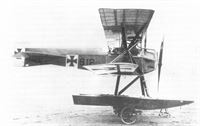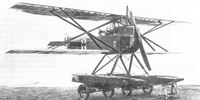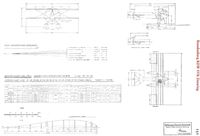
Описание
Страна: Германия
Год: 1916
Single-seat seaplane fighting scout
Варианты
- Hansa-Brandenburg - D.I/KD - 1916 - Германия
- Hansa-Brandenburg - KDD - 1916 - Германия
- Hansa-Brandenburg - KDW - 1916 - Германия
- Hansa-Brandenburg - W.11 - 1916 - Германия
- Hansa-Brandenburg - C.II / K - 1917 - Германия
- Hansa-Brandenburg - W.25 - 1917 - Германия
- Phonix - C.I - 1917 - Австро-Венгрия
- Phonix - D.I/D.II/D.III - 1917 - Австро-Венгрия
- Phonix - D.IV / 20.24 / 20.25 - 1918 - Австро-Венгрия
- В.Обухович, А.Никифоров Самолеты Первой Мировой войны
- O.Thetford, P.Gray German Aircraft of the First World War (Putnam)
- W.Green, G.Swanborough The Complete Book of Fighters
- J.Herris German Seaplane Fighters of WWI (A Centennial Perspective on Great War Airplanes 2)
- C.Owers Hansa-Brandenburg Aircraft of WWI Vol.2: Biplane Seaplanes (A Centennial Perspective on Great War Airplanes 18)
- M.Dusing German Aviation Industry in WWI. Volume 1 (A Centennial Perspective on Great War Airplanes 84)
-
M.Schmeelke - "Torpedo Los!" /Aeronaut/
Marine #748 was the first KDW prototype. It was finished in stained wood for the fuselage and floats and clear-doped linen flying surfaces.
-
C.Owers - Hansa-Brandenburg Aircraft of WWI. Volume 2 - Biplane Seaplanes /Centennial Perspective/ (18)
Marine #748 was the first KDW prototype. It was finished in stained wood for the fuselage and floats and clear-doped linen flying surfaces.
-
C.Owers - Hansa-Brandenburg Aircraft of WWI. Volume 2 - Biplane Seaplanes /Centennial Perspective/ (18)
Marine #921 was the last KDW in the first production batch. Like the prototypes, it was finished in stained wood for the fuselage and floats and clear-doped linen flying surfaces.
-
C.Owers - Hansa-Brandenburg Aircraft of WWI. Volume 2 - Biplane Seaplanes /Centennial Perspective/ (18)
Marine #1562 was part of the fourth and last KDW production batch. It was finished in the standard late-war German naval camouflage with three-color printed fabric on upper surfaces.
-
C.Owers - Hansa-Brandenburg Aircraft of WWI. Volume 2 - Biplane Seaplanes /Centennial Perspective/ (18)
This striking view of Marine #748, the first prototype, shows the washed out ailerons. Many WWI airplanes had the angle of attack of their ailerons reduced or 'washed out' to ensure the inner part of the wing stalled before the outer part, where the ailerons were fitted. With no 'wash out', the outer part of the wing would stall first and the pilot would lose aileron control at the beginning of the stall, making a spin much more likely. The metal fairings enclosing the apex of the wing star-struts of #748 are not seen on later aircraft.
The KDW was a floatplane development of the D.I fighter used by Austria but not Germany. Ltn. Fritz Hammer used #748 to down a Russian Ilya Mouromets bomber in September 1916, one of only three downed by German aircraft in air combat. Although credited as a victory, the badly damaged bomber crash-landed at its base with three of it four crewmen wounded. -
J.Herris - German Seaplane Fighters of WWI /Centennial Perspective/ (2)
The prototype KDW Marine #748, as confirmed by the fairings over the apex of the struts. The Marine Number has not yet been applied.
-
C.Owers - Hansa-Brandenburg Aircraft of WWI. Volume 2 - Biplane Seaplanes /Centennial Perspective/ (18)
The KDW prototype before armament was fitted. No Marine Number is visible and the frontal, car-type radiator and overall aerodynamic cleanliness of the design are prominent.
-
J.Herris - German Seaplane Fighters of WWI /Centennial Perspective/ (2)
The KDW prototype before armament was fitted. No Marine Number is visible and the frontal, car-type radiator and overall aerodynamic cleanliness of the design are prominent.
-
M.Schmeelke - "Torpedo Los!" /Aeronaut/
KDW #748, the machine used by Lt.d.RMI Fritz Hammer at Angernsee to bring down Sikorski IM-6 on 23 Sept 1916. The basic sturdiness of the design was tested during Hammer's running combat, in which he made four separate passes at the Russian bomber, once nearly losing control when he was caught in the turbulence of the bomber's wake. Note the position of the machine gun, which was so far forward that the muzzle can be seen close to the radiator.
-
M.Schmeelke - "Torpedo Los!" /Aeronaut/
Hammer criticized the inaccessibility of the gun on the starboard side of #748, clearly out of reach, after his combat with the Sikorski. According to Hammer he might have been able to clear the simple jam that occurred on his fourth pass had he been able to reach this gun.
-
J.Herris - Development of German Warplanes in WWI /Centennial Perspective/ (1)
The KDW (Kampf Doppeldecker Wasser - literally 'combat biplane water') was Brandenburg's response to the single-seat floatplane fighter requirement. Based on their KD fighter, used as the Brandenburg D.I by the Austro-Hungarians but not by Germany, the KDW had the KD's unusual 'star-struts' that were streamlined and eliminated the need for bracing wires, but weighed more and interfered with the pilot's field of view. The KDW also had larger wings to support the additional weight of its floats. Marine #748 shown here was the prototype and forced down a Sikorski Ilya Mouromets in September 1916, one of only three downed by German aircraft during the war. Initially armed with a single synchronized gun, the last production batch of 20 aircraft could carry two guns. The KDW inherited the KD's problematic flying qualities and field of view for the pilot and only 58 were built.
Hammer criticized the inaccessibility of the gun on the starboard side of #748, clearly out of reach, after his combat with the Sikorski. According to Hammer he might have been able to clear the simple jam that occurred on his fourth pass had he been able to reach this gun. -
A.Imrie - German Naval Air Service /Arms & Armour/
Only a few days after its acceptance on 23 September 1916, this Brandenburg KDW (748), flown by Leutnant Hammer from the Baltic air station at Angernsee, forced a large four-engined Russian Sikorsky to land by repeated attacks. Despite this initial success the KDW was unpopular with its pilots; it was said to be heavy and difficult to fly, and had such a poor forward view that it was considered unsuitable for air fighting due to the constant risk of collision that this imposed. It was known as the 'Spider' in service, due to the unusual star-strut arrangement of its interplane bracing struts. A total of 58 machines of the type was delivered, latterly having a 160hp Maybach engine in place of the 150hp Benz installed in the first production machines.
-
C.Owers - Hansa-Brandenburg Aircraft of WWI. Volume 2 - Biplane Seaplanes /Centennial Perspective/ (18)
The prototype KDW Marine #748, as confirmed by the fairings over the apex of the struts. The Marine Number has not yet been applied.
-
J.Herris - German Seaplane Fighters of WWI /Centennial Perspective/ (2)
Marine Number 783, the second KDW prototype, showing its frontal radiator. The machine gun is far forward, out of the pilot's reach in case of jams. The wing structure is evident through the fabric. The Balkenkreuz on the wings appear to be painted over white backgrounds. Although it is difficult to see in this view, there is no fixed fin above the fuselage.
-
C.Owers - Hansa-Brandenburg Aircraft of WWI. Volume 2 - Biplane Seaplanes /Centennial Perspective/ (18)
Marine Number 783, the second KDW prototype, showing its frontal radiator. The machine gun is far forward, out of the pilot's reach in case of jams. The wing structure is evident through the fabric. The Balkenkreuz on the wings appear to be painted over white backgrounds. Although it is difficult to see in this view, there is no fixed fin above the fuselage.
-
C.Owers - Hansa-Brandenburg Aircraft of WWI. Volume 2 - Biplane Seaplanes /Centennial Perspective/ (18)
The inaccessible location of the machinegun is also clearly evident on the second KDW prototype, Marine #783. This aircraft was being ferried from Warnemunde to Windau by Lt.z.S. Joachim Cooler when it was forced down near Memel on 23 Sept., 1916. This aircraft may not have completed its journey, for it does not appear in subsequent flying entries at Windau. In March, 1917, Coeler was ordered to the Putzig Seekampfeinsitzerschule to be its commander. KDW Marine #748 is in the right background, identified by the metal fairings at the apex of its interplane struts.
-
C.Owers - Hansa-Brandenburg Aircraft of WWI. Volume 2 - Biplane Seaplanes /Centennial Perspective/ (18)
Marine Number 783, the second KDW prototype, clearly shows the forward mounting of the machine gun in this photo. Although the view of the rudder is washed out, the only fixed fin is shown below the fuselage.
-
C.Owers - Hansa-Brandenburg Aircraft of WWI. Volume 2 - Biplane Seaplanes /Centennial Perspective/ (18)
Side view of Marine Number 912, the first production KDW, shows the machine gun has been moved back to enable the pilot to reach it in flight to clear jams. This change was made on the basis of early combat reports on #748.
-
J.Herris - German Seaplane Fighters of WWI /Centennial Perspective/ (2)
Side view of Marine Number 912, the first production KDW, shows the machine gun has been moved back to enable the pilot to reach it in flight to clear jams. This change was made on the basis of early combat reports on #748.
-
M.Dusing - German Aviation Industry in WWI. Volume 1 /Centennial Perspective/ (84)
The Brandenburg KDW was the last model where only letters were used as the model designation. The following seaplane designations started with a "W".
-
C.Owers - Hansa-Brandenburg Aircraft of WWI. Volume 2 - Biplane Seaplanes /Centennial Perspective/ (18)
Another KDW from the first production batch was Marine #921, which initially went to Libau, arriving there on 24 Feb., 1917. This aircraft was apparently at Putzig by May, and was wrecked while being flown by Lt. Markwald on 11 August, 1917. This photo was taken in front of a Hansa-Brandenburg hangar, apparently prior to June, 1917, when additional bracing struts were ordered to be installed on all KDWs.
-
M.Dusing - German Aviation Industry in WWI. Volume 1 /Centennial Perspective/ (84)
Brandenburg KDW in front of the H.B.F. hangar in Hamburg-Fuhlsbuttel.
-
J.Herris - German Seaplane Fighters of WWI /Centennial Perspective/ (2)
An early Brandenburg KDW (no vertical fin above the fuselage) is launched as the pilot enters the cockpit. The engine appears to be a Benz due to the exhaust stack.
-
C.Owers - Hansa-Brandenburg Aircraft of WWI. Volume 2 - Biplane Seaplanes /Centennial Perspective/ (18)
The first KDW from the initial production batch, Marine #912 went to Zeebrugge. On 10 May, 1917, this aircraft was wrecked while being flown by Oblt.z.S Kurt Reinert, who later died from the injuries he sustained. Note that that Lt. Hammer's remarks were heeded; the machine gun is now located closer to the cockpit. Also the radiator has been moved to the upper wing, just right of center.
-
C.Owers - Hansa-Brandenburg Aircraft of WWI. Volume 2 - Biplane Seaplanes /Centennial Perspective/ (18)
A late production KDW, Marine Number unknown, displays the fixed upper fin added to later aircraft to improve stability and the additional small interplane struts added for better aileron effectiveness. Compare this aircraft with #1562 of the last production batch; this aircraft retains the plain finish of early production KDWs and the intermediate location of the guns, so may be of the third production batch.
-
C.Owers - Hansa-Brandenburg Aircraft of WWI. Volume 2 - Biplane Seaplanes /Centennial Perspective/ (18)
This appears to be another photo of the KDW, and provides an interesting view of the star struts augmented with the auxiliary bracing struts. This arrangement was strong and eliminated the need for drag-producing bracing wires, but was heavier than conventional wing bracing. The additional weight and drag of the auxiliary bracing struts basically eliminated the advantages of the star-strut design, and later designs returned to conventional wing struts.
-
J.Herris - German Seaplane Fighters of WWI /Centennial Perspective/ (2)
This appears to be another photo of the KDW above, and provides an interesting view of the star struts augmented with the auxiliary bracing struts. This arrangement was strong and eliminated the need for drag-producing bracing wires, but was heavier than conventional wing bracing. The additional weight and drag of the auxiliary bracing struts basically eliminated the advantages of the star-strut design, and later designs returned to conventional wing struts.
-
C.Owers - Hansa-Brandenburg Aircraft of WWI. Volume 2 - Biplane Seaplanes /Centennial Perspective/ (18)
This later production Brandenburg KDW illustrates inherent design problems and attempted solutions. The unusual 'star-strutter' interplane bracing struts were strong and, made of triangles, eliminated the need for drag-producing bracing cables. This enabled the KDW to be fairly fast. However, the struts were heavy and the wing cellule would twist when ailerons were used. To stiffen the wing cellule in torsion in order to improve aileron effectiveness, outboard auxiliary struts were added as shown. Moreover, stability and flying qualities were poor. A supplementary fixed fin was added to the top of the rear fuselage in an attempt to improve directional stability due to the too-small vertical tail. The lack of wing dihedral meant lateral stability was also inadequate. The design problems could not be completely solved and the KDW was withdrawn from combat due to excessive accidents due to poor flying qualities despite that it was strong and fast.
-
C.Owers - Hansa-Brandenburg Aircraft of WWI. Volume 2 - Biplane Seaplanes /Centennial Perspective/ (18)
These photos, Marine Number unknown, clearly shows the light interplane struts ordered to be added to all KDWs in June, 1917. The light struts run from the front spar of the lower wing to both spars of the upper wing and increased the torsional stiffness of the upper wing, which improved aileron response. Compared to the prototypes, the machine gun has been moved back closer to give the pilot better access in case of jams. A fixed vertical fin has been added above the fuselage, which was not done on early production batches.
-
C.Owers - Hansa-Brandenburg Aircraft of WWI. Volume 2 - Biplane Seaplanes /Centennial Perspective/ (18)
A KDW from the last production batch, #1562 was one of the aircraft originally sent to II.Seefliegerabteilung, presumably for assignment to a western front unit. Following a series of crashes at the Seekampfeinsitzerschule at Putzig, this and several other II.SFA machines were ordered to be transferred to I.SFA and sent to the Putzig school. Standard late naval lozenge camouflage was applied to this machine. The fixed vertical fin above the fuselage is enlarged compared to the prototypes and early production machines.
-
C.Owers - Hansa-Brandenburg Aircraft of WWI. Volume 2 - Biplane Seaplanes /Centennial Perspective/ (18)
Marine Number 1562 of the final KDW production batch displays the additional interplane struts and shows off the three-color hexagonal camouflage fabric used on the upper surfaces of German naval aircraft late in the war. The machine guns have been moved up in front of the pilot for better access.
-
J.Herris - German Seaplane Fighters of WWI /Centennial Perspective/ (2)
Marine Number 1562 of the final KDW production batch displays the additional interplane struts and shows off the three-color hexagonal camouflage fabric used on the upper surfaces of German naval aircraft late in the war. The machine guns have been moved up in front of the pilot for better access.
Essentially a float-equipped version of the Ernst Heinkel-designed Hansa-Brandenburg KD/D I of early 1916, with added outboard wing bracing, the first of the navy's 58 Hansa-Brandenburg KDWs was completed in September 1916. Typically, no less than three different engine types were fitted to the KDW, the initial 150hp Benz Bz III to the 13 aircraft, followed by the 160hp Mercedes D III in the next 10, while the last 35 machines received the 160hp Maybach Mb III. In the first 23 of these single seat fighters only one 7.92mm Spandau was fitted, whereas the last 35 mounted twin Spandaus. Top level speed was 106mph for the later fighters and range was cited as 310 miles. From a pilot's viewpoint, the KDW was not highly thought of, having virtually none existent visibility directly forward. -
J.Herris - German Seaplane Fighters of WWI /Centennial Perspective/ (2)
Lt. d.RMi Fritz Hammer, flying the KDW prototype, Marine Number 748, from the German naval air station at Angernsee, downs a Russian four-engine Sikorski Il'ya Mouromets reconnaissance-bomber on 23 September 1916. Sikorski IM-6 crash-landed at its base with 293 bullet holes and three of its four crewmen wounded. This was one of only three air-to-air victories scored over these tough bombers during the war.
Другие самолёты на фотографии: Сикорский Илья Муромец серии В - Россия - 1915
-
W.Green, G.Swanborough - The Complete Book of Fighters
The KDW was essentially a float-equipped conversion of the KD "star strutter".
-
C.Owers - Hansa-Brandenburg Aircraft of WWI. Volume 2 - Biplane Seaplanes /Centennial Perspective/ (18)
Brandenburg KDW SVK Drawing
-
C.Owers - Hansa-Brandenburg Aircraft of WWI. Volume 2 - Biplane Seaplanes /Centennial Perspective/ (18)
Brandenburg KDW SVK Drawing
-
C.Owers - Hansa-Brandenburg Aircraft of WWI. Volume 2 - Biplane Seaplanes /Centennial Perspective/ (18)
Brandenburg KDW SVK Drawing
В.Обухович, А.Никифоров Самолеты Первой Мировой войны
На основе KD был разработан поплавковый одноместный разведчик-истребитель KDW.
Описание:










































